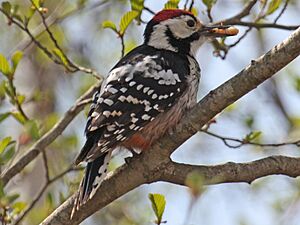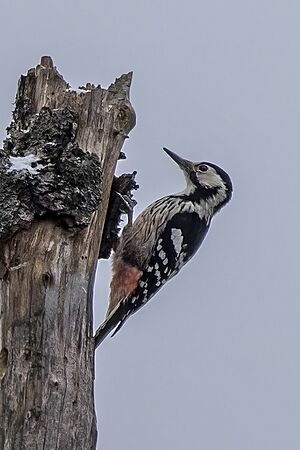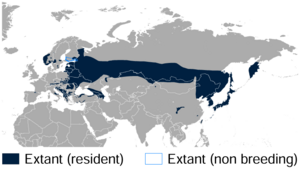White-backed woodpecker facts for kids
Quick facts for kids White-backed woodpecker |
|
|---|---|
 |
|
| Male | |
 |
|
| Female | |
| Conservation status | |
| Scientific classification | |
| Genus: |
Dendrocopos
|
| Species: |
leucotos
|
 |
|
| White-backed Woodpecker range | |
 |
|
| White-backed Woodpecker range in Europe and western Asia | |
The white-backed woodpecker (Dendrocopos leucotos) is a cool bird found across Eurasia, which is a huge landmass including Europe and Asia. It's a type of woodpecker and belongs to a group of birds called Dendrocopos. These woodpeckers are known for their striking white lower backs, which gives them their name.
Contents
About the White-backed Woodpecker
What's in a Name?
The white-backed woodpecker was first described by a German scientist named Johann Matthäus Bechstein in 1802. He gave it the scientific name Picus leucotos. The word leucotos comes from ancient Greek words. Leukos means "white," and -nōtos means "-backed." So, its name literally means "white-backed"! Later, this bird was placed in the Dendrocopos group by another German scientist, Carl Ludwig Koch, in 1816.
Different Types of White-backed Woodpeckers
Just like there are different breeds of dogs, there are different types of white-backed woodpeckers called subspecies. Scientists have found twelve different subspecies of this bird. They live in various parts of the world, from Europe all the way to Japan. Each subspecies might have small differences in their looks or where they live.
For example, some subspecies include:
- D. l. leucotos: Found across Europe and northeast Asia.
- D. l. uralensis: Lives near the Ural Mountains in Russia.
- D. l. lilfordi: Found from the Pyrenees mountains to Turkey.
- D. l. subcirris: Lives on Hokkaido, an island in northern Japan.
- D. l. owstoni: Found on Amami Ōshima Island in Japan. Sometimes, this one is even considered its own separate species!
How to Spot a White-backed Woodpecker
The white-backed woodpecker is the biggest of the spotted woodpeckers in Europe and western Asia. It grows to be about 24–26 centimeters (about 9-10 inches) long. Its wings can spread out to 38–40 centimeters (about 15-16 inches) wide.
Its plumage (which means its feathers) looks a bit like the great spotted woodpecker. But you can tell them apart because the white-backed woodpecker has white stripes across its wings instead of spots. And, of course, it has that clear white lower back!
You can also tell if it's a male or female. Male white-backed woodpeckers have a bright red cap on their heads. Females, on the other hand, have a black cap.
Sounds They Make
These woodpeckers are quite noisy! When males drum on trees, it's very loud. They also make different calls, like a soft "kiuk" sound and a longer "kweek."
Where White-backed Woodpeckers Live
You can find white-backed woodpeckers in many places across Europe and Asia. The main type, D. l. leucotos, lives in central and northern Europe. Another type, D. l. lilfordi, is found in the Balkan region and Turkey. Ten more types live further east, all the way to Korea and Japan.
These birds are quite rare. They need large areas of old forests with lots of dead trees, both standing and fallen. This is because they find their food and make their homes in these dead trees.
Sadly, their numbers have been going down in countries like Sweden. Because of this, the Swedish government has created a special plan called a Biodiversity Action Plan. This plan helps protect the white-backed woodpecker and its home, trying to keep them from disappearing.
White-backed Woodpecker Life Cycle
Making a Home
During the breeding season, the white-backed woodpecker digs a nest hole in a decaying (rotting) tree trunk. This hole is usually about 7 centimeters (about 3 inches) wide and 30 centimeters (about 12 inches) deep.
Eggs and Young
The female woodpecker lays three to five white eggs inside the nest. Both parents take turns sitting on the eggs to keep them warm. This is called incubating, and it lasts for about 10–11 days until the chicks hatch.
What They Eat
White-backed woodpeckers mostly eat insects that live in wood, like wood-boring beetles and their larvae (which are like baby insects). They also enjoy other insects, nuts, seeds, and berries.
How Long They Live
In the wild, a white-backed woodpecker usually lives for about three to four years. But if they are cared for by humans, like in a zoo, they can live much longer, sometimes up to eleven years!


